About Plants For Bad Soil
Most plants like a well-draining, nutrient-rich, loamy soil that has a mix of sand, silt, and clay combined with organic matter. It checks all the boxes for most types of plants but not all of them. Some plants actually like less hospitable types of soil. So if you’re looking for plants for bad soil, it’s a good idea to identify what type of soil you’re working with. A soil test can help you determine that. Then you can narrow it down to the types of plants that will fit your particular soil medium along with the sun exposure if any for the location.
Top 8 Best Plants for Poor Soil
Once you’ve determined what you have in terms of soil, it’s time to pick out plants. It can be overwhelming, so I’ve compiled a list of my top 8 best plants for poor soil.
1. Lavender
I can attest that lavender can be difficult to grow; in an area of the perpetually wet PNW at any rate. That being said, when I moved to a different area, lavender seemed to be the blooming herb of choice. It is extremely tolerant of a variety of soils from compact to rocky, but what it must have is good drainage and at least 8 hours of sun or more. Provide this aromatic beauty with these two conditions, and you’ve got a tough, long-lasting option for nearly every type of soil in your landscape.
2. Heuchera
Tree-filled areas are often problem areas to plant. The roots of the trees may only be a few inches deep, leaving little room for any species with a deeper root system. In this case, heuchera (also known as coral bells) is an excellent option. Not only does heuchera come in a variety of stunning foliage colors, but it has a shallow root system and prefers the more shaded environment beneath a stand of trees. This English variety of lavender can grow in the toughest of spots and still delight you with blooms all summer.
3. Coneflower
Coneflower (Echinacea purpurea) is native to the prairies of North America. This resilient flowering perennial comes in an array of hues that will enliven drab areas of the landscape. It tolerates drought and humidity and thrives in poor soils such as compacted clay. It’s also a magnet for beneficial pollinators.
4. Arborvitae
If you’re looking for a fast-growing shrub/tree that’s unfussy about its location, try planting arborvitae. This evergreen grows rapidly to create a privacy screen yet cares little about the quality of its soil. While they can be grown in partial shade, arborvitae prefer full sun. There are quite a few varieties, some of which can exceed heights of 40-60 feet (12-18 m) while others a more moderate 15 feet (4.5 m) in height. This tough native flower has butter yellow petals and will flourish even in poor, dry soil.
5. Butterfly Weed
Butterfly weed (Asclepias tuberosa), another North American native and a type of milkweed, can be grown in USDA zones 3-9 in soil ranging from clay to sand. Quite resilient, butterfly weed blooms with a profusion of orange flowers in the spring. Plant butterfly weed in full sun where it will mature to a height of about 1-2 feet tall (30-61 cm) and wide. A heavy nectar producer, its common name refers to the numerous butterflies it attracts.
6. Stonecrop or Sedum
I’m a big fan of stonecrop perennials and have several in my landscape. Part of the Crassulaceae family, there are about 600 species in the Northern Hemisphere running the gamut from shrubs, perennials, annuals, and creepers. They thrive in well-draining sunny areas of shallow, sandy or rocky soil. All have fat succulent leaves and small clusters of colorful blooms and can be grown in USDA zones 3-9. Incredibly hardy and drought tolerant, stonecrop works well in xeriscaping and rock gardens. This flower from Green Promise Farms will keep the pollinators coming back for more.
7. Black Eyed Susan
An extremely resilient perennial, black eyed Susan (Rudbeckia hirta) can be grown in USDA zones 3-10. These plants are incredibly cold hardy and can also tolerate high heat and humidity. They are unfazed by poor soils like heavy clay or sand. Prized for its reliably blooming sunny orange heads accented with black centers, black-eyed Susan spreads in the garden through self-seeding and rhizomes.
8. Viburnum
Viburnum odoratissimum is a large, diverse group of shrubs or small trees whose clusters of blooms are generally highly aromatic. Despite the dainty blossoms, viburnum is actually one tough cookie and thrives in a variety of soil types in USDA zones 3-8 in full sun to partial shade. Most viburnum shrubs bloom from spring to June, followed by attractive fruit and beautiful fall foliage. This article features products available from third-party vendors on the Gardening Know How Shop.
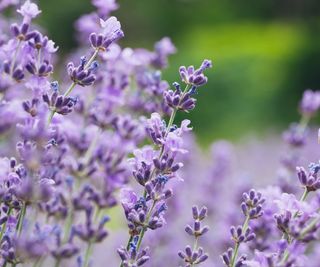
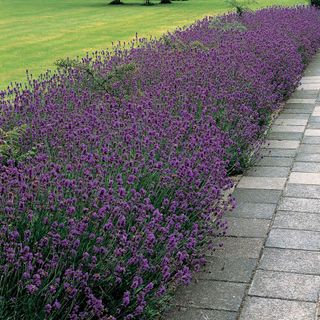
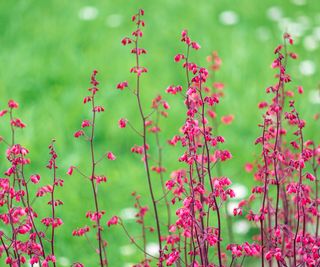
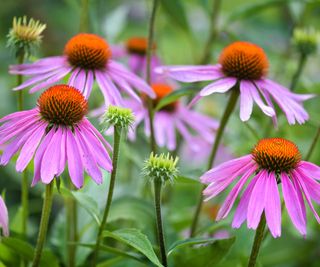
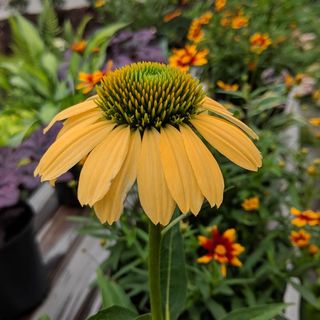
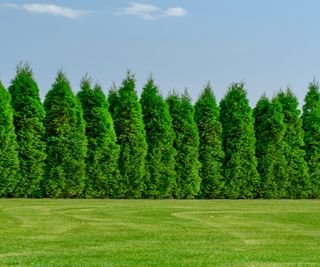
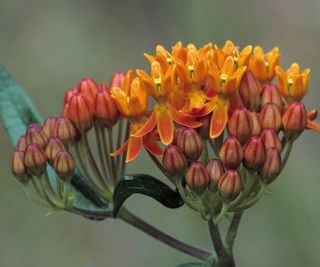
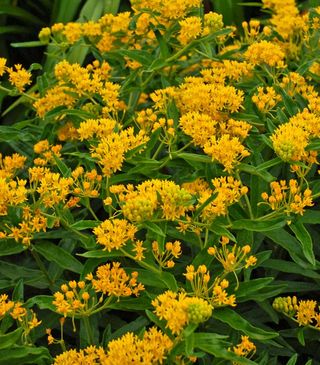
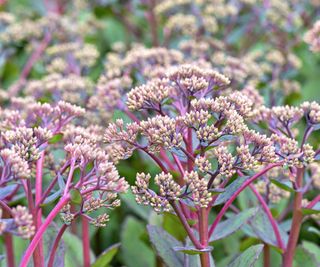
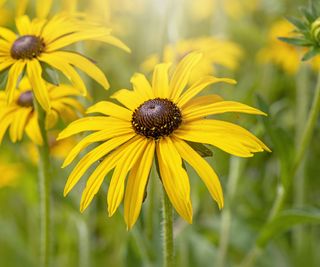
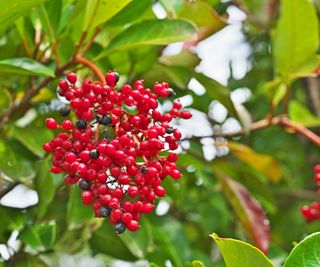
title: “8 Plants For Poor Soil That Will Grow Absolutely Anywhere” ShowToc: true date: “2024-08-28” author: “Helen Calliste”
About Plants For Bad Soil
Most plants like a well-draining, nutrient-rich, loamy soil that has a mix of sand, silt, and clay combined with organic matter. It checks all the boxes for most types of plants but not all of them. Some plants actually like less hospitable types of soil. So if you’re looking for plants for bad soil, it’s a good idea to identify what type of soil you’re working with. A soil test can help you determine that. Then you can narrow it down to the types of plants that will fit your particular soil medium along with the sun exposure if any for the location.
Top 8 Best Plants for Poor Soil
Once you’ve determined what you have in terms of soil, it’s time to pick out plants. It can be overwhelming, so I’ve compiled a list of my top 8 best plants for poor soil.
1. Lavender
I can attest that lavender can be difficult to grow; in an area of the perpetually wet PNW at any rate. That being said, when I moved to a different area, lavender seemed to be the blooming herb of choice. It is extremely tolerant of a variety of soils from compact to rocky, but what it must have is good drainage and at least 8 hours of sun or more. Provide this aromatic beauty with these two conditions, and you’ve got a tough, long-lasting option for nearly every type of soil in your landscape.
2. Heuchera
Tree-filled areas are often problem areas to plant. The roots of the trees may only be a few inches deep, leaving little room for any species with a deeper root system. In this case, heuchera (also known as coral bells) is an excellent option. Not only does heuchera come in a variety of stunning foliage colors, but it has a shallow root system and prefers the more shaded environment beneath a stand of trees. This English variety of lavender can grow in the toughest of spots and still delight you with blooms all summer.
3. Coneflower
Coneflower (Echinacea purpurea) is native to the prairies of North America. This resilient flowering perennial comes in an array of hues that will enliven drab areas of the landscape. It tolerates drought and humidity and thrives in poor soils such as compacted clay. It’s also a magnet for beneficial pollinators.
4. Arborvitae
If you’re looking for a fast-growing shrub/tree that’s unfussy about its location, try planting arborvitae. This evergreen grows rapidly to create a privacy screen yet cares little about the quality of its soil. While they can be grown in partial shade, arborvitae prefer full sun. There are quite a few varieties, some of which can exceed heights of 40-60 feet (12-18 m) while others a more moderate 15 feet (4.5 m) in height. This tough native flower has butter yellow petals and will flourish even in poor, dry soil.
5. Butterfly Weed
Butterfly weed (Asclepias tuberosa), another North American native and a type of milkweed, can be grown in USDA zones 3-9 in soil ranging from clay to sand. Quite resilient, butterfly weed blooms with a profusion of orange flowers in the spring. Plant butterfly weed in full sun where it will mature to a height of about 1-2 feet tall (30-61 cm) and wide. A heavy nectar producer, its common name refers to the numerous butterflies it attracts.
6. Stonecrop or Sedum
I’m a big fan of stonecrop perennials and have several in my landscape. Part of the Crassulaceae family, there are about 600 species in the Northern Hemisphere running the gamut from shrubs, perennials, annuals, and creepers. They thrive in well-draining sunny areas of shallow, sandy or rocky soil. All have fat succulent leaves and small clusters of colorful blooms and can be grown in USDA zones 3-9. Incredibly hardy and drought tolerant, stonecrop works well in xeriscaping and rock gardens. This flower from Green Promise Farms will keep the pollinators coming back for more.
7. Black Eyed Susan
An extremely resilient perennial, black eyed Susan (Rudbeckia hirta) can be grown in USDA zones 3-10. These plants are incredibly cold hardy and can also tolerate high heat and humidity. They are unfazed by poor soils like heavy clay or sand. Prized for its reliably blooming sunny orange heads accented with black centers, black-eyed Susan spreads in the garden through self-seeding and rhizomes.
8. Viburnum
Viburnum odoratissimum is a large, diverse group of shrubs or small trees whose clusters of blooms are generally highly aromatic. Despite the dainty blossoms, viburnum is actually one tough cookie and thrives in a variety of soil types in USDA zones 3-8 in full sun to partial shade. Most viburnum shrubs bloom from spring to June, followed by attractive fruit and beautiful fall foliage. This article features products available from third-party vendors on the Gardening Know How Shop.











title: “8 Plants For Poor Soil That Will Grow Absolutely Anywhere” ShowToc: true date: “2024-09-15” author: “Jenifer Perez”
About Plants For Bad Soil
Most plants like a well-draining, nutrient-rich, loamy soil that has a mix of sand, silt, and clay combined with organic matter. It checks all the boxes for most types of plants but not all of them. Some plants actually like less hospitable types of soil. So if you’re looking for plants for bad soil, it’s a good idea to identify what type of soil you’re working with. A soil test can help you determine that. Then you can narrow it down to the types of plants that will fit your particular soil medium along with the sun exposure if any for the location.
Top 8 Best Plants for Poor Soil
Once you’ve determined what you have in terms of soil, it’s time to pick out plants. It can be overwhelming, so I’ve compiled a list of my top 8 best plants for poor soil.
1. Lavender
I can attest that lavender can be difficult to grow; in an area of the perpetually wet PNW at any rate. That being said, when I moved to a different area, lavender seemed to be the blooming herb of choice. It is extremely tolerant of a variety of soils from compact to rocky, but what it must have is good drainage and at least 8 hours of sun or more. Provide this aromatic beauty with these two conditions, and you’ve got a tough, long-lasting option for nearly every type of soil in your landscape.
2. Heuchera
Tree-filled areas are often problem areas to plant. The roots of the trees may only be a few inches deep, leaving little room for any species with a deeper root system. In this case, heuchera (also known as coral bells) is an excellent option. Not only does heuchera come in a variety of stunning foliage colors, but it has a shallow root system and prefers the more shaded environment beneath a stand of trees. This English variety of lavender can grow in the toughest of spots and still delight you with blooms all summer.
3. Coneflower
Coneflower (Echinacea purpurea) is native to the prairies of North America. This resilient flowering perennial comes in an array of hues that will enliven drab areas of the landscape. It tolerates drought and humidity and thrives in poor soils such as compacted clay. It’s also a magnet for beneficial pollinators.
4. Arborvitae
If you’re looking for a fast-growing shrub/tree that’s unfussy about its location, try planting arborvitae. This evergreen grows rapidly to create a privacy screen yet cares little about the quality of its soil. While they can be grown in partial shade, arborvitae prefer full sun. There are quite a few varieties, some of which can exceed heights of 40-60 feet (12-18 m) while others a more moderate 15 feet (4.5 m) in height. This tough native flower has butter yellow petals and will flourish even in poor, dry soil.
5. Butterfly Weed
Butterfly weed (Asclepias tuberosa), another North American native and a type of milkweed, can be grown in USDA zones 3-9 in soil ranging from clay to sand. Quite resilient, butterfly weed blooms with a profusion of orange flowers in the spring. Plant butterfly weed in full sun where it will mature to a height of about 1-2 feet tall (30-61 cm) and wide. A heavy nectar producer, its common name refers to the numerous butterflies it attracts.
6. Stonecrop or Sedum
I’m a big fan of stonecrop perennials and have several in my landscape. Part of the Crassulaceae family, there are about 600 species in the Northern Hemisphere running the gamut from shrubs, perennials, annuals, and creepers. They thrive in well-draining sunny areas of shallow, sandy or rocky soil. All have fat succulent leaves and small clusters of colorful blooms and can be grown in USDA zones 3-9. Incredibly hardy and drought tolerant, stonecrop works well in xeriscaping and rock gardens. This flower from Green Promise Farms will keep the pollinators coming back for more.
7. Black Eyed Susan
An extremely resilient perennial, black eyed Susan (Rudbeckia hirta) can be grown in USDA zones 3-10. These plants are incredibly cold hardy and can also tolerate high heat and humidity. They are unfazed by poor soils like heavy clay or sand. Prized for its reliably blooming sunny orange heads accented with black centers, black-eyed Susan spreads in the garden through self-seeding and rhizomes.
8. Viburnum
Viburnum odoratissimum is a large, diverse group of shrubs or small trees whose clusters of blooms are generally highly aromatic. Despite the dainty blossoms, viburnum is actually one tough cookie and thrives in a variety of soil types in USDA zones 3-8 in full sun to partial shade. Most viburnum shrubs bloom from spring to June, followed by attractive fruit and beautiful fall foliage. This article features products available from third-party vendors on the Gardening Know How Shop.











title: “8 Plants For Poor Soil That Will Grow Absolutely Anywhere” ShowToc: true date: “2024-09-10” author: “Leah Walker”
About Plants For Bad Soil
Most plants like a well-draining, nutrient-rich, loamy soil that has a mix of sand, silt, and clay combined with organic matter. It checks all the boxes for most types of plants but not all of them. Some plants actually like less hospitable types of soil. So if you’re looking for plants for bad soil, it’s a good idea to identify what type of soil you’re working with. A soil test can help you determine that. Then you can narrow it down to the types of plants that will fit your particular soil medium along with the sun exposure if any for the location.
Top 8 Best Plants for Poor Soil
Once you’ve determined what you have in terms of soil, it’s time to pick out plants. It can be overwhelming, so I’ve compiled a list of my top 8 best plants for poor soil.
1. Lavender
I can attest that lavender can be difficult to grow; in an area of the perpetually wet PNW at any rate. That being said, when I moved to a different area, lavender seemed to be the blooming herb of choice. It is extremely tolerant of a variety of soils from compact to rocky, but what it must have is good drainage and at least 8 hours of sun or more. Provide this aromatic beauty with these two conditions, and you’ve got a tough, long-lasting option for nearly every type of soil in your landscape.
2. Heuchera
Tree-filled areas are often problem areas to plant. The roots of the trees may only be a few inches deep, leaving little room for any species with a deeper root system. In this case, heuchera (also known as coral bells) is an excellent option. Not only does heuchera come in a variety of stunning foliage colors, but it has a shallow root system and prefers the more shaded environment beneath a stand of trees. This English variety of lavender can grow in the toughest of spots and still delight you with blooms all summer.
3. Coneflower
Coneflower (Echinacea purpurea) is native to the prairies of North America. This resilient flowering perennial comes in an array of hues that will enliven drab areas of the landscape. It tolerates drought and humidity and thrives in poor soils such as compacted clay. It’s also a magnet for beneficial pollinators.
4. Arborvitae
If you’re looking for a fast-growing shrub/tree that’s unfussy about its location, try planting arborvitae. This evergreen grows rapidly to create a privacy screen yet cares little about the quality of its soil. While they can be grown in partial shade, arborvitae prefer full sun. There are quite a few varieties, some of which can exceed heights of 40-60 feet (12-18 m) while others a more moderate 15 feet (4.5 m) in height. This tough native flower has butter yellow petals and will flourish even in poor, dry soil.
5. Butterfly Weed
Butterfly weed (Asclepias tuberosa), another North American native and a type of milkweed, can be grown in USDA zones 3-9 in soil ranging from clay to sand. Quite resilient, butterfly weed blooms with a profusion of orange flowers in the spring. Plant butterfly weed in full sun where it will mature to a height of about 1-2 feet tall (30-61 cm) and wide. A heavy nectar producer, its common name refers to the numerous butterflies it attracts.
6. Stonecrop or Sedum
I’m a big fan of stonecrop perennials and have several in my landscape. Part of the Crassulaceae family, there are about 600 species in the Northern Hemisphere running the gamut from shrubs, perennials, annuals, and creepers. They thrive in well-draining sunny areas of shallow, sandy or rocky soil. All have fat succulent leaves and small clusters of colorful blooms and can be grown in USDA zones 3-9. Incredibly hardy and drought tolerant, stonecrop works well in xeriscaping and rock gardens. This flower from Green Promise Farms will keep the pollinators coming back for more.
7. Black Eyed Susan
An extremely resilient perennial, black eyed Susan (Rudbeckia hirta) can be grown in USDA zones 3-10. These plants are incredibly cold hardy and can also tolerate high heat and humidity. They are unfazed by poor soils like heavy clay or sand. Prized for its reliably blooming sunny orange heads accented with black centers, black-eyed Susan spreads in the garden through self-seeding and rhizomes.
8. Viburnum
Viburnum odoratissimum is a large, diverse group of shrubs or small trees whose clusters of blooms are generally highly aromatic. Despite the dainty blossoms, viburnum is actually one tough cookie and thrives in a variety of soil types in USDA zones 3-8 in full sun to partial shade. Most viburnum shrubs bloom from spring to June, followed by attractive fruit and beautiful fall foliage. This article features products available from third-party vendors on the Gardening Know How Shop.











title: “8 Plants For Poor Soil That Will Grow Absolutely Anywhere” ShowToc: true date: “2024-10-04” author: “Glenn Powell”
About Plants For Bad Soil
Most plants like a well-draining, nutrient-rich, loamy soil that has a mix of sand, silt, and clay combined with organic matter. It checks all the boxes for most types of plants but not all of them. Some plants actually like less hospitable types of soil. So if you’re looking for plants for bad soil, it’s a good idea to identify what type of soil you’re working with. A soil test can help you determine that. Then you can narrow it down to the types of plants that will fit your particular soil medium along with the sun exposure if any for the location.
Top 8 Best Plants for Poor Soil
Once you’ve determined what you have in terms of soil, it’s time to pick out plants. It can be overwhelming, so I’ve compiled a list of my top 8 best plants for poor soil.
1. Lavender
I can attest that lavender can be difficult to grow; in an area of the perpetually wet PNW at any rate. That being said, when I moved to a different area, lavender seemed to be the blooming herb of choice. It is extremely tolerant of a variety of soils from compact to rocky, but what it must have is good drainage and at least 8 hours of sun or more. Provide this aromatic beauty with these two conditions, and you’ve got a tough, long-lasting option for nearly every type of soil in your landscape.
2. Heuchera
Tree-filled areas are often problem areas to plant. The roots of the trees may only be a few inches deep, leaving little room for any species with a deeper root system. In this case, heuchera (also known as coral bells) is an excellent option. Not only does heuchera come in a variety of stunning foliage colors, but it has a shallow root system and prefers the more shaded environment beneath a stand of trees. This English variety of lavender can grow in the toughest of spots and still delight you with blooms all summer.
3. Coneflower
Coneflower (Echinacea purpurea) is native to the prairies of North America. This resilient flowering perennial comes in an array of hues that will enliven drab areas of the landscape. It tolerates drought and humidity and thrives in poor soils such as compacted clay. It’s also a magnet for beneficial pollinators.
4. Arborvitae
If you’re looking for a fast-growing shrub/tree that’s unfussy about its location, try planting arborvitae. This evergreen grows rapidly to create a privacy screen yet cares little about the quality of its soil. While they can be grown in partial shade, arborvitae prefer full sun. There are quite a few varieties, some of which can exceed heights of 40-60 feet (12-18 m) while others a more moderate 15 feet (4.5 m) in height. This tough native flower has butter yellow petals and will flourish even in poor, dry soil.
5. Butterfly Weed
Butterfly weed (Asclepias tuberosa), another North American native and a type of milkweed, can be grown in USDA zones 3-9 in soil ranging from clay to sand. Quite resilient, butterfly weed blooms with a profusion of orange flowers in the spring. Plant butterfly weed in full sun where it will mature to a height of about 1-2 feet tall (30-61 cm) and wide. A heavy nectar producer, its common name refers to the numerous butterflies it attracts.
6. Stonecrop or Sedum
I’m a big fan of stonecrop perennials and have several in my landscape. Part of the Crassulaceae family, there are about 600 species in the Northern Hemisphere running the gamut from shrubs, perennials, annuals, and creepers. They thrive in well-draining sunny areas of shallow, sandy or rocky soil. All have fat succulent leaves and small clusters of colorful blooms and can be grown in USDA zones 3-9. Incredibly hardy and drought tolerant, stonecrop works well in xeriscaping and rock gardens. This flower from Green Promise Farms will keep the pollinators coming back for more.
7. Black Eyed Susan
An extremely resilient perennial, black eyed Susan (Rudbeckia hirta) can be grown in USDA zones 3-10. These plants are incredibly cold hardy and can also tolerate high heat and humidity. They are unfazed by poor soils like heavy clay or sand. Prized for its reliably blooming sunny orange heads accented with black centers, black-eyed Susan spreads in the garden through self-seeding and rhizomes.
8. Viburnum
Viburnum odoratissimum is a large, diverse group of shrubs or small trees whose clusters of blooms are generally highly aromatic. Despite the dainty blossoms, viburnum is actually one tough cookie and thrives in a variety of soil types in USDA zones 3-8 in full sun to partial shade. Most viburnum shrubs bloom from spring to June, followed by attractive fruit and beautiful fall foliage. This article features products available from third-party vendors on the Gardening Know How Shop.











title: “8 Plants For Poor Soil That Will Grow Absolutely Anywhere” ShowToc: true date: “2024-09-30” author: “James Kosse”
About Plants For Bad Soil
Most plants like a well-draining, nutrient-rich, loamy soil that has a mix of sand, silt, and clay combined with organic matter. It checks all the boxes for most types of plants but not all of them. Some plants actually like less hospitable types of soil. So if you’re looking for plants for bad soil, it’s a good idea to identify what type of soil you’re working with. A soil test can help you determine that. Then you can narrow it down to the types of plants that will fit your particular soil medium along with the sun exposure if any for the location.
Top 8 Best Plants for Poor Soil
Once you’ve determined what you have in terms of soil, it’s time to pick out plants. It can be overwhelming, so I’ve compiled a list of my top 8 best plants for poor soil.
1. Lavender
I can attest that lavender can be difficult to grow; in an area of the perpetually wet PNW at any rate. That being said, when I moved to a different area, lavender seemed to be the blooming herb of choice. It is extremely tolerant of a variety of soils from compact to rocky, but what it must have is good drainage and at least 8 hours of sun or more. Provide this aromatic beauty with these two conditions, and you’ve got a tough, long-lasting option for nearly every type of soil in your landscape.
2. Heuchera
Tree-filled areas are often problem areas to plant. The roots of the trees may only be a few inches deep, leaving little room for any species with a deeper root system. In this case, heuchera (also known as coral bells) is an excellent option. Not only does heuchera come in a variety of stunning foliage colors, but it has a shallow root system and prefers the more shaded environment beneath a stand of trees. This English variety of lavender can grow in the toughest of spots and still delight you with blooms all summer.
3. Coneflower
Coneflower (Echinacea purpurea) is native to the prairies of North America. This resilient flowering perennial comes in an array of hues that will enliven drab areas of the landscape. It tolerates drought and humidity and thrives in poor soils such as compacted clay. It’s also a magnet for beneficial pollinators.
4. Arborvitae
If you’re looking for a fast-growing shrub/tree that’s unfussy about its location, try planting arborvitae. This evergreen grows rapidly to create a privacy screen yet cares little about the quality of its soil. While they can be grown in partial shade, arborvitae prefer full sun. There are quite a few varieties, some of which can exceed heights of 40-60 feet (12-18 m) while others a more moderate 15 feet (4.5 m) in height. This tough native flower has butter yellow petals and will flourish even in poor, dry soil.
5. Butterfly Weed
Butterfly weed (Asclepias tuberosa), another North American native and a type of milkweed, can be grown in USDA zones 3-9 in soil ranging from clay to sand. Quite resilient, butterfly weed blooms with a profusion of orange flowers in the spring. Plant butterfly weed in full sun where it will mature to a height of about 1-2 feet tall (30-61 cm) and wide. A heavy nectar producer, its common name refers to the numerous butterflies it attracts.
6. Stonecrop or Sedum
I’m a big fan of stonecrop perennials and have several in my landscape. Part of the Crassulaceae family, there are about 600 species in the Northern Hemisphere running the gamut from shrubs, perennials, annuals, and creepers. They thrive in well-draining sunny areas of shallow, sandy or rocky soil. All have fat succulent leaves and small clusters of colorful blooms and can be grown in USDA zones 3-9. Incredibly hardy and drought tolerant, stonecrop works well in xeriscaping and rock gardens. This flower from Green Promise Farms will keep the pollinators coming back for more.
7. Black Eyed Susan
An extremely resilient perennial, black eyed Susan (Rudbeckia hirta) can be grown in USDA zones 3-10. These plants are incredibly cold hardy and can also tolerate high heat and humidity. They are unfazed by poor soils like heavy clay or sand. Prized for its reliably blooming sunny orange heads accented with black centers, black-eyed Susan spreads in the garden through self-seeding and rhizomes.
8. Viburnum
Viburnum odoratissimum is a large, diverse group of shrubs or small trees whose clusters of blooms are generally highly aromatic. Despite the dainty blossoms, viburnum is actually one tough cookie and thrives in a variety of soil types in USDA zones 3-8 in full sun to partial shade. Most viburnum shrubs bloom from spring to June, followed by attractive fruit and beautiful fall foliage. This article features products available from third-party vendors on the Gardening Know How Shop.











title: “8 Plants For Poor Soil That Will Grow Absolutely Anywhere” ShowToc: true date: “2024-09-21” author: “Shawn Kowalski”
About Plants For Bad Soil
Most plants like a well-draining, nutrient-rich, loamy soil that has a mix of sand, silt, and clay combined with organic matter. It checks all the boxes for most types of plants but not all of them. Some plants actually like less hospitable types of soil. So if you’re looking for plants for bad soil, it’s a good idea to identify what type of soil you’re working with. A soil test can help you determine that. Then you can narrow it down to the types of plants that will fit your particular soil medium along with the sun exposure if any for the location.
Top 8 Best Plants for Poor Soil
Once you’ve determined what you have in terms of soil, it’s time to pick out plants. It can be overwhelming, so I’ve compiled a list of my top 8 best plants for poor soil.
1. Lavender
I can attest that lavender can be difficult to grow; in an area of the perpetually wet PNW at any rate. That being said, when I moved to a different area, lavender seemed to be the blooming herb of choice. It is extremely tolerant of a variety of soils from compact to rocky, but what it must have is good drainage and at least 8 hours of sun or more. Provide this aromatic beauty with these two conditions, and you’ve got a tough, long-lasting option for nearly every type of soil in your landscape.
2. Heuchera
Tree-filled areas are often problem areas to plant. The roots of the trees may only be a few inches deep, leaving little room for any species with a deeper root system. In this case, heuchera (also known as coral bells) is an excellent option. Not only does heuchera come in a variety of stunning foliage colors, but it has a shallow root system and prefers the more shaded environment beneath a stand of trees. This English variety of lavender can grow in the toughest of spots and still delight you with blooms all summer.
3. Coneflower
Coneflower (Echinacea purpurea) is native to the prairies of North America. This resilient flowering perennial comes in an array of hues that will enliven drab areas of the landscape. It tolerates drought and humidity and thrives in poor soils such as compacted clay. It’s also a magnet for beneficial pollinators.
4. Arborvitae
If you’re looking for a fast-growing shrub/tree that’s unfussy about its location, try planting arborvitae. This evergreen grows rapidly to create a privacy screen yet cares little about the quality of its soil. While they can be grown in partial shade, arborvitae prefer full sun. There are quite a few varieties, some of which can exceed heights of 40-60 feet (12-18 m) while others a more moderate 15 feet (4.5 m) in height. This tough native flower has butter yellow petals and will flourish even in poor, dry soil.
5. Butterfly Weed
Butterfly weed (Asclepias tuberosa), another North American native and a type of milkweed, can be grown in USDA zones 3-9 in soil ranging from clay to sand. Quite resilient, butterfly weed blooms with a profusion of orange flowers in the spring. Plant butterfly weed in full sun where it will mature to a height of about 1-2 feet tall (30-61 cm) and wide. A heavy nectar producer, its common name refers to the numerous butterflies it attracts.
6. Stonecrop or Sedum
I’m a big fan of stonecrop perennials and have several in my landscape. Part of the Crassulaceae family, there are about 600 species in the Northern Hemisphere running the gamut from shrubs, perennials, annuals, and creepers. They thrive in well-draining sunny areas of shallow, sandy or rocky soil. All have fat succulent leaves and small clusters of colorful blooms and can be grown in USDA zones 3-9. Incredibly hardy and drought tolerant, stonecrop works well in xeriscaping and rock gardens. This flower from Green Promise Farms will keep the pollinators coming back for more.
7. Black Eyed Susan
An extremely resilient perennial, black eyed Susan (Rudbeckia hirta) can be grown in USDA zones 3-10. These plants are incredibly cold hardy and can also tolerate high heat and humidity. They are unfazed by poor soils like heavy clay or sand. Prized for its reliably blooming sunny orange heads accented with black centers, black-eyed Susan spreads in the garden through self-seeding and rhizomes.
8. Viburnum
Viburnum odoratissimum is a large, diverse group of shrubs or small trees whose clusters of blooms are generally highly aromatic. Despite the dainty blossoms, viburnum is actually one tough cookie and thrives in a variety of soil types in USDA zones 3-8 in full sun to partial shade. Most viburnum shrubs bloom from spring to June, followed by attractive fruit and beautiful fall foliage. This article features products available from third-party vendors on the Gardening Know How Shop.











title: “8 Plants For Poor Soil That Will Grow Absolutely Anywhere” ShowToc: true date: “2024-10-04” author: “Lucille Reiland”
About Plants For Bad Soil
Most plants like a well-draining, nutrient-rich, loamy soil that has a mix of sand, silt, and clay combined with organic matter. It checks all the boxes for most types of plants but not all of them. Some plants actually like less hospitable types of soil. So if you’re looking for plants for bad soil, it’s a good idea to identify what type of soil you’re working with. A soil test can help you determine that. Then you can narrow it down to the types of plants that will fit your particular soil medium along with the sun exposure if any for the location.
Top 8 Best Plants for Poor Soil
Once you’ve determined what you have in terms of soil, it’s time to pick out plants. It can be overwhelming, so I’ve compiled a list of my top 8 best plants for poor soil.
1. Lavender
I can attest that lavender can be difficult to grow; in an area of the perpetually wet PNW at any rate. That being said, when I moved to a different area, lavender seemed to be the blooming herb of choice. It is extremely tolerant of a variety of soils from compact to rocky, but what it must have is good drainage and at least 8 hours of sun or more. Provide this aromatic beauty with these two conditions, and you’ve got a tough, long-lasting option for nearly every type of soil in your landscape.
2. Heuchera
Tree-filled areas are often problem areas to plant. The roots of the trees may only be a few inches deep, leaving little room for any species with a deeper root system. In this case, heuchera (also known as coral bells) is an excellent option. Not only does heuchera come in a variety of stunning foliage colors, but it has a shallow root system and prefers the more shaded environment beneath a stand of trees. This English variety of lavender can grow in the toughest of spots and still delight you with blooms all summer.
3. Coneflower
Coneflower (Echinacea purpurea) is native to the prairies of North America. This resilient flowering perennial comes in an array of hues that will enliven drab areas of the landscape. It tolerates drought and humidity and thrives in poor soils such as compacted clay. It’s also a magnet for beneficial pollinators.
4. Arborvitae
If you’re looking for a fast-growing shrub/tree that’s unfussy about its location, try planting arborvitae. This evergreen grows rapidly to create a privacy screen yet cares little about the quality of its soil. While they can be grown in partial shade, arborvitae prefer full sun. There are quite a few varieties, some of which can exceed heights of 40-60 feet (12-18 m) while others a more moderate 15 feet (4.5 m) in height. This tough native flower has butter yellow petals and will flourish even in poor, dry soil.
5. Butterfly Weed
Butterfly weed (Asclepias tuberosa), another North American native and a type of milkweed, can be grown in USDA zones 3-9 in soil ranging from clay to sand. Quite resilient, butterfly weed blooms with a profusion of orange flowers in the spring. Plant butterfly weed in full sun where it will mature to a height of about 1-2 feet tall (30-61 cm) and wide. A heavy nectar producer, its common name refers to the numerous butterflies it attracts.
6. Stonecrop or Sedum
I’m a big fan of stonecrop perennials and have several in my landscape. Part of the Crassulaceae family, there are about 600 species in the Northern Hemisphere running the gamut from shrubs, perennials, annuals, and creepers. They thrive in well-draining sunny areas of shallow, sandy or rocky soil. All have fat succulent leaves and small clusters of colorful blooms and can be grown in USDA zones 3-9. Incredibly hardy and drought tolerant, stonecrop works well in xeriscaping and rock gardens. This flower from Green Promise Farms will keep the pollinators coming back for more.
7. Black Eyed Susan
An extremely resilient perennial, black eyed Susan (Rudbeckia hirta) can be grown in USDA zones 3-10. These plants are incredibly cold hardy and can also tolerate high heat and humidity. They are unfazed by poor soils like heavy clay or sand. Prized for its reliably blooming sunny orange heads accented with black centers, black-eyed Susan spreads in the garden through self-seeding and rhizomes.
8. Viburnum
Viburnum odoratissimum is a large, diverse group of shrubs or small trees whose clusters of blooms are generally highly aromatic. Despite the dainty blossoms, viburnum is actually one tough cookie and thrives in a variety of soil types in USDA zones 3-8 in full sun to partial shade. Most viburnum shrubs bloom from spring to June, followed by attractive fruit and beautiful fall foliage. This article features products available from third-party vendors on the Gardening Know How Shop.











title: “8 Plants For Poor Soil That Will Grow Absolutely Anywhere” ShowToc: true date: “2024-09-24” author: “Elma Scheer”
About Plants For Bad Soil
Most plants like a well-draining, nutrient-rich, loamy soil that has a mix of sand, silt, and clay combined with organic matter. It checks all the boxes for most types of plants but not all of them. Some plants actually like less hospitable types of soil. So if you’re looking for plants for bad soil, it’s a good idea to identify what type of soil you’re working with. A soil test can help you determine that. Then you can narrow it down to the types of plants that will fit your particular soil medium along with the sun exposure if any for the location.
Top 8 Best Plants for Poor Soil
Once you’ve determined what you have in terms of soil, it’s time to pick out plants. It can be overwhelming, so I’ve compiled a list of my top 8 best plants for poor soil.
1. Lavender
I can attest that lavender can be difficult to grow; in an area of the perpetually wet PNW at any rate. That being said, when I moved to a different area, lavender seemed to be the blooming herb of choice. It is extremely tolerant of a variety of soils from compact to rocky, but what it must have is good drainage and at least 8 hours of sun or more. Provide this aromatic beauty with these two conditions, and you’ve got a tough, long-lasting option for nearly every type of soil in your landscape.
2. Heuchera
Tree-filled areas are often problem areas to plant. The roots of the trees may only be a few inches deep, leaving little room for any species with a deeper root system. In this case, heuchera (also known as coral bells) is an excellent option. Not only does heuchera come in a variety of stunning foliage colors, but it has a shallow root system and prefers the more shaded environment beneath a stand of trees. This English variety of lavender can grow in the toughest of spots and still delight you with blooms all summer.
3. Coneflower
Coneflower (Echinacea purpurea) is native to the prairies of North America. This resilient flowering perennial comes in an array of hues that will enliven drab areas of the landscape. It tolerates drought and humidity and thrives in poor soils such as compacted clay. It’s also a magnet for beneficial pollinators.
4. Arborvitae
If you’re looking for a fast-growing shrub/tree that’s unfussy about its location, try planting arborvitae. This evergreen grows rapidly to create a privacy screen yet cares little about the quality of its soil. While they can be grown in partial shade, arborvitae prefer full sun. There are quite a few varieties, some of which can exceed heights of 40-60 feet (12-18 m) while others a more moderate 15 feet (4.5 m) in height. This tough native flower has butter yellow petals and will flourish even in poor, dry soil.
5. Butterfly Weed
Butterfly weed (Asclepias tuberosa), another North American native and a type of milkweed, can be grown in USDA zones 3-9 in soil ranging from clay to sand. Quite resilient, butterfly weed blooms with a profusion of orange flowers in the spring. Plant butterfly weed in full sun where it will mature to a height of about 1-2 feet tall (30-61 cm) and wide. A heavy nectar producer, its common name refers to the numerous butterflies it attracts.
6. Stonecrop or Sedum
I’m a big fan of stonecrop perennials and have several in my landscape. Part of the Crassulaceae family, there are about 600 species in the Northern Hemisphere running the gamut from shrubs, perennials, annuals, and creepers. They thrive in well-draining sunny areas of shallow, sandy or rocky soil. All have fat succulent leaves and small clusters of colorful blooms and can be grown in USDA zones 3-9. Incredibly hardy and drought tolerant, stonecrop works well in xeriscaping and rock gardens. This flower from Green Promise Farms will keep the pollinators coming back for more.
7. Black Eyed Susan
An extremely resilient perennial, black eyed Susan (Rudbeckia hirta) can be grown in USDA zones 3-10. These plants are incredibly cold hardy and can also tolerate high heat and humidity. They are unfazed by poor soils like heavy clay or sand. Prized for its reliably blooming sunny orange heads accented with black centers, black-eyed Susan spreads in the garden through self-seeding and rhizomes.
8. Viburnum
Viburnum odoratissimum is a large, diverse group of shrubs or small trees whose clusters of blooms are generally highly aromatic. Despite the dainty blossoms, viburnum is actually one tough cookie and thrives in a variety of soil types in USDA zones 3-8 in full sun to partial shade. Most viburnum shrubs bloom from spring to June, followed by attractive fruit and beautiful fall foliage. This article features products available from third-party vendors on the Gardening Know How Shop.










